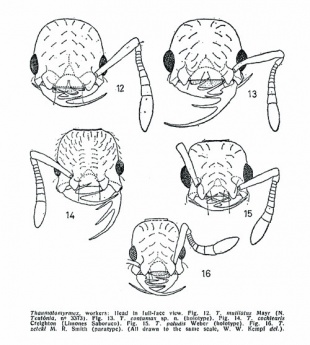Thaumatomyrmex contumax
| Thaumatomyrmex contumax | |
|---|---|
| Scientific classification | |
| Kingdom: | Animalia |
| Phylum: | Arthropoda |
| Class: | Insecta |
| Order: | Hymenoptera |
| Family: | Formicidae |
| Subfamily: | Ponerinae |
| Tribe: | Ponerini |
| Genus: | Thaumatomyrmex |
| Species: | T. contumax |
| Binomial name | |
| Thaumatomyrmex contumax Kempf, 1975 | |
| At a Glance | • Gamergate |
Identification
Keys including this Species
Distribution
Latitudinal Distribution Pattern
Latitudinal Range: -8.667° to -19.805°.
| North Temperate |
North Subtropical |
Tropical | South Subtropical |
South Temperate |
- Source: AntMaps
Distribution based on Regional Taxon Lists
Neotropical Region: Brazil (type locality).
Distribution based on AntMaps
Distribution based on AntWeb specimens
Check data from AntWeb
Countries Occupied
| Number of countries occupied by this species based on AntWiki Regional Taxon Lists. In general, fewer countries occupied indicates a narrower range, while more countries indicates a more widespread species. |

|
Estimated Abundance
| Relative abundance based on number of AntMaps records per species (this species within the purple bar). Fewer records (to the left) indicates a less abundant/encountered species while more records (to the right) indicates more abundant/encountered species. |

|
Biology
Castes
Nomenclature
The following information is derived from Barry Bolton's Online Catalogue of the Ants of the World.
- contumax. Thaumatomyrmex contumax Kempf, 1975b: 108, figs. 13, 22, 33 (w.) BRAZIL (Pernambuco).
- Type-material: holotype worker.
- Type-locality: Brazil: Pernambuco, Araripina, 4.i.1973 (R. Montenegro).
- Type-depository: MZSP.
- Status as species: Brandão, 1991: 381; Brandão, Diniz & Tomotake, 1991: 336; Bolton, 1995b: 420; Jahyny, et al. 2008: 332; Feitosa, 2015c: 99.
- Distribution: Brazil.
Type Material
BRAZIL, Pernambuco State: Araripina, January 4, 1973, Raúl Montenegro leg. (n. 407) 1 female (holotype; WWK 8443).
Description
Worker
(holotype). TL 4.1 mm; HL 0.81 mm; HW 0.95 mm; CI 116; ML 1.04 mm; MI 127; IfW 0.68 mm; IfI 72; SL 0.72 mm; SI 89; WL 1.24 mm; PnW 0.60 mm; HfL 0.91 mm; HfI 96; PW 0.72 mm. Extremely close to Thaumatomyrmex mutilatus from which it differs in the following significant characters: head (Fig. 13) absolutely and relatively (as compared with head length) broader, cephalic index 116 (95-105 in mutilatus). Mandibles (Fig. 33) absolutely and relatively (as compared with head length) longer, mandibular index 127 (86-102 in mutilatus), the apical spine proportionately and absolutely longer, the tip projecting beyond the maximum width of head across eyes (included) when mandibles are closed, and the proximal spines distinctly cross each other on clypeus. Hind femur distinctly shorter than head width (HfI 96). Mid-coxae (fore and hind coxae black), all trochanters and basal third of femora ferruginous, apical two thirds of femora brownish black; tibiae pale testaceous; antennae dark brown.
The thorax and the petiole, which do not present any noticeable difference from those of mutilatus, are shown in Fig. 22.

|

|

|
Karyotype
- n = 30, 2n = 60, karyotype = 22M + 38A (Brazil) (Mariano et al., 2015).
References
- Brandão, C. R. F.; Diniz, J. L. M.; Tomotake, E. M. 1991. Thaumatomyrmex strips millipedes for prey: a novel predatory behaviour in ants, and the first case of sympatry in the genus (Hymenoptera: Formicidae). Insectes Soc. 38: 335-344 (page 336, see also)
- Burchill, A.T., Moreau, C.S. 2016. Colony size evolution in ants: macroevolutionary trends. Insectes Sociaux 63, 291–298 (doi:10.1007/s00040-016-0465-3).
- Delabie, J. H. C.; Fresneau, D.; Pezon, A. 2000. Notes on the ecology of Thaumatomyrmex spp. (Hymenoptera: Formicidae: Ponerinae) in southeast Bahia, Brazil. Sociobiology 36: 571-584 (page 571, see also)
- Jahyny, B. 2010. Histoire Naturelle du genre de fourmis néotropical Thaumatomyrmex Mayr 1887 (Arthropoda, Insecta, Hymenoptera, Formicidae, Ponerinae, Thaumatomyrmecini). Unpublished Ph.D. thesis, Université Paris XIII, Villetaneuse, 581 pp.
- Kempf, W. W. 1975. A revision of the Neotropical ponerine ant genus Thaumatomyrmex Mayr (Hymenoptera: Formicidae). Stud. Entomol. 18: 95-126 (page 108, figs. 13, 22, 33 worker described)
- Mariano, C.S.F., Santos, I.S., Silva, J.G., Costa, M.A., Pompolo, S.G. 2015. Citogenética e evolução do cariótipo em formigas poneromorfas. In: Delabie, J.H.C., Feitosa, R.M., Serrao, J.E., Mariano, C.S.F., Majer, J.D. (eds) As formigas poneromorfas do Brasil, 1st edn. Ilhéus, Brasil, pp 102–125 (doi:10.7476/9788574554419.0010).
- Troya, A., Marcineiro, F., Lattke, J.E. & Longino, J. 2022. Igaponera curiosa, a new ponerine genus (Hymenoptera: Formicidae) from the Amazon. European Journal of Taxonomy 823: 82–101 (doi:10.5852/ejt.2022.823.1817).
- Ulysséa, M.A., Brandão, C.R.F. 2013. Ant species (Hymenoptera, Formicidae) from the seasonally dry tropical forest of northeastern Brazil: a compilation from field surveys in Bahia and literature records. Revista Brasileira de Entomologia 57, 217–224 (doi:10.1590/s0085-56262013005000002).
References based on Global Ant Biodiversity Informatics
- Santos P. P., A. Vasconcelos, B. Jahyny, and J. H. C. Delabie. 2010. Ant fauna (Hymenoptera, Formicidae) associated to arboreal nests of Nasutitermes spp. (Isoptera, Termitidae) in a cacao plantation in southeastern Bahia, Brazil. Revista Brasileira de Entomologia 54(3): 450-454.
- Scott-Santos, C.P., F.A. Esteves, C.R.F. Brandao. 2008. Catalogue of "Poneromorph" ant type specimens (Hymenoptera, Formicidae) deposited in the Museu de Zoologia da Universidade de Sao Paulo, Brazil. Papeis Avulsos de Zoologia 48(11):75-88.
- Siqueira de Castro F., A. B. Gontijo, W. Duarte da Rocha, and S. Pontes Ribeiro. 2011. As comunidades de formigas de serapilheira nas florestas semidecíduas do Parque Estadual do Rio Doce, Minas Gerais. MG.BIOTA, Belo Horizonte 3(5): 5-24.
- Ulyssea M. A., and C. R. F. Brandao. 2013. Ant species (Hymenoptera, Formicidae) from the seasonally dry tropical forest of northeastern Brazil: a compilation from field surveys in Bahia and literature records. Revista Brasileira de Entomologia 57(2): 217224.

